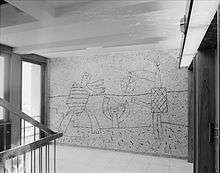Picasso's Regjeringskvartalet murals
In the late 1950s and the early 1970s the Spanish artist Pablo Picasso designed five murals (The Beach, The Seagull, Satyr and Faun and two versions of The Fisherman) for the Regjeringskvartalet ('Government quarter') buildings in central Oslo, Norway.[1] The designs by Picasso were executed in concrete by Norwegian artist Carl Nesjar, and were Picasso's first attempt at monumental concrete murals.[1][2] The buildings onto which the murals were executed are known as the 'H-block' or Highrise (1959) and 'Y-block' (1968); they were designed by the Norwegian architect Erling Viksjø.[3] The largest mural, The Fisherman (1970) is on the façade of Y-block. Picasso would later create works in a similar vein in Barcelona and Stockholm.[2]


2011 Norway attacks
The Regjeringskvartalet complex was badly damaged by a car bomb that exploded on 22 July 2011.[1] The Highrise block and the Y-block had no structural damages after the bombing. Despite this a long discourse has happened , as the governemnet wanted to demolish both buildings by Architect Erling Viksjø. The H-block was saved, but the Y-block is under threat. .[1] The Regjeringskvartalet government complex is Norways most iconic modernist buildings. .[1]
The Y-block from 1969 forms together with the H-block from 1958 the modernist contribution to the government quarter of Oslo. Just before the attack in 2011, both buildings were about to be granted protection by the Directorate of Cultural Heritage. Experts, inside and outside of Norway, agree on its immeasurable value and try to convince the government to stop the demolition plans. Europa Nostra included the y-block in its list of Europes most endagered buildings in 2020.
The Y-block is one of Viksjø’s most beautiful buildings that is constructed in Naturbetong, a special concrete casting technique he developed together with engineer Sverre Jystad that was patented in 1955/-57. The possibilities that lay in this new material with sandblasted surfaces were decisive for Picasso’s contribution and lead to a 17-year long collaboration with the Norwegian artist Carl Nesjar. The development of Naturbetong with its integration of art is a unique contribution to Norwegian and international modernism. Only one more building worldwide, the House of Architects in Barcelona, have this kind of integral art by Picasso and Nesjar in public space.
The murals were subsequently listed as one of Europe's most endangered heritage sites in 2015 by the heritage organisation Europa Nostra following the Norwegian cabinet's vote to demolish the Y-block building.[4]
References
- Tony Paterson (18 August 2013). "Norway's 'ugly' buildings – with a touch of Picasso's genius – under threat of demolition". The Independent.
- Clemens Bomsdorf (14 January 2013). "Picasso murals under threat". The Art Newspaper.
- "Picasso – Oslo. Art and architecture in the Government quarter". Visit Oslo. Archived from the original on 22 August 2013.
- Henri Neuendorf. "Picasso Mural in Norway Among Europe's Most Threatened Heritage Sites". ArtNet News. ArtNet. Retrieved 14 March 2016.
